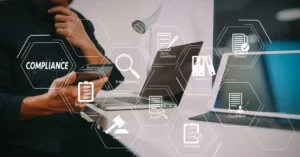October is National Cybersecurity Awareness Month, and we thought we’d share some of our very best tips and tricks to help you and your business keep your data and network safe in the modern ever-changing threat landscape. Cyberattacks can happen anytime, so being aware is crucial. That’s why cybersecurity in the modern business starts with you. It is your job to keep information safe. Sure, you can improve the tools you use to keep your infrastructure free from threats, but ultimately, to protect this data, you will need to stay vigilant.
Any data you collect, you must protect. You might not think your business is big enough (or noteworthy enough) to be targeted by hackers, but the truth is, those are the reasons you are a target. It is estimated that by 2020, more than 24 billion devices will be connected to the Internet, so it is imperative that you follow simple, yet crucial, steps to ensure your data and information are kept safe.
Here are some variables you–and the other people on your network–need to be aware of.
Phishing
Phishing attacks are some of the most prevalent attacks being made in 2019. Basically, users will send you an email that seems to be from a user the recipient might know. If a user interacts with that email by clicking on a link or downloading an attachment, the phishing scam is a success. A successful phishing scam is a huge problem for your business.
You will want to train your staff on how to spot and avoid phishing attacks. Phishing attacks have been developed to be subtle and admittedly easy to miss. There are, however, several tell-tale signs that an email is legitimate. Hackers know that the weakest link in any business or organization is the employees. Do your employees know how to recognize an out of place email? It is crucial that you take the time to train your employees the art of phishing identification.
Secure Passwords
Passwords are the standard in which most people use to keep files secure and to authenticate access to devices, platforms, programs, etc. Understanding what makes a strong password can go a long way toward securing your IT resources. Some best practices include:
- Creating strong, unique passphrases
- Changing passwords frequently
- Using Upper and Lowercase letters, numbers, and symbols
Multi-factor Authentication
Multi-factor authentication, often rolled out as two-factor authentication, puts an additional step between you, and potential threats to your network or data. You use a password to unlock a 2FA/MFA platform that requires you to get a randomly-generated code from a third-party device to gain access. Since you need a third-party device/account to open the application, account, or device protected by 2FA/MFA, that account is more than twice as secure.
Applications and Software Updates
In order to say ahead of security attacks, the software you use cannot have vulnerabilities. As a result, patching and updating software is essential to comprehensive security. If you are going to remain secure you will want to be sure to stay up-to-date on your updates.
How Do I Know If My Systems are Safe?
So, you want to know if you are safe from a cyberattack? To put it lightly: nobody is. By associating security preparedness with cybersecurity and routinely taking proactive, preventative measures to enhance your security position, you reduce the chance that your organization will have to suffer from downtime, data loss, and reputation damage that a data breach would bring your company.
If you would like more tips; or, if you would like to talk to one of our experts about network security, call us today at (973) 659-1350.







